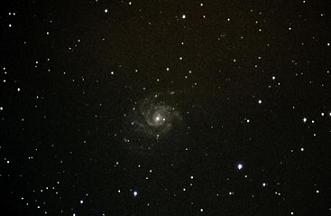|
M101 - Pinwheel Galaxy
The Pinwheel Galaxy (also known as Messier 101 or NGC 5457) is a face-on
spiral galaxy distanced 21 million
light-years (six
megaparsecs) away in the
constellation
Ursa Major, first
discovered by
Pierre Méchain on March 27, 1781, and
communicated to
Charles Messier who verified its
position for inclusion in the
Messier Catalogue as one of its final entries.
On February 28, 2006, NASA
and the ESA
released a very detailed image of the Pinwheel Galaxy, which was the largest and
most detailed image of a galaxy by
Hubble Space Telescope at the time. The
image was composed from 51 individual exposures, plus some extra ground-based
photos.
On August 24, 2011, a
Type Ia supernova,
SN 2011fe, was
discovered in M101.
M101 is a relatively large galaxy compared to the Milky Way. With a
diameter of 170,000 light-years it is seventy percent larger than the Milky Way.
It has a disk mass on the order of 100 billion solar masses, along with a small
bulge of about 3 billion solar masses.
Another remarkable property of this galaxy is its huge and extremely bright
H II regions, of which a total of about
3,000 can be seen on photographs. H II regions usually accompany the enormous
clouds of high density molecular hydrogen gas contracting under their own
gravitational force where
stars form. H II regions are ionized by
large numbers of extremely bright and hot young stars.
On photographs M101 can be seen to be asymmetrical on one side. It is thought
that in the recent past (speaking in galactic terms) M101 underwent a near
collision with another galaxy and the associated gravitational
tidal forces caused the asymmetry. In addition, this encounter also
amplified the density waves in the spiral arms of M101. The amplification of
these waves leads to the compression of the
interstellar hydrogen gas, which then
triggers strong
star formation activity.
Click on images for high resolution (opens new browser)

|
|
Equipment: Orion ED80
Camera: Unmodified Canon Rebel XT 350D
Prime Focus
25-30 seconds images
Darks, Flats, Offsets applied
ISO800
Stacked with DeepSkyStacker
Processed with PhotoShop CS
© 2007 Antonio Pascarella
|
|
|
|
|
|